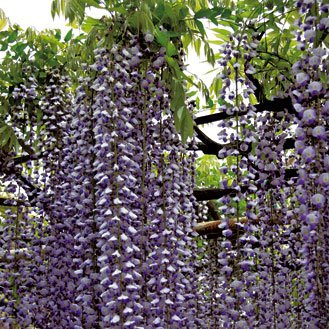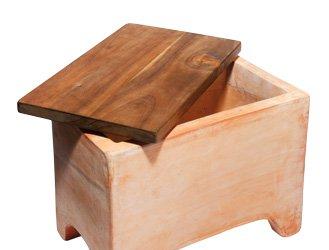The size of glycine
Wisteria foliage
On a balcony, in front
On which support to install it?
Choose your glycine
The flowering of glycine
Planted for two years, it has never bloomed.
Give him another year of rest before making a decision. Some wisteria can sulphase for 2-3 years, the time to install their roots . Check its origin. Seedlings are unreliable and can take up to 20 years to flower. Prefer a grafted plant , much more regular in its setting flower.
I chose a white wisteria , it blooms blue.
This happens as a result of a labeling error. Buy your wisteria in bloom, you will avoid this kind of disappointment. Another possibility: you bought a white glycine but a rejection developed under the graft . This vigorous rejection, with blue flowers, has taken over the variety grafted with white flowers. We can not go back, but next time, avoid burying the graft and protect it.
She was beautiful, she stopped blooming ...
Again, it may be that a rejection has gone under the graft and has become dominant. Your wisteria will bloom again but it can take years. Its flowers will no longer have the characteristics of the grafted variety but those of the rootstock, usually a Chinese wisteria . Another cause: you no longer prune your glycine. Delivered to itself, it will naturally form more foliage than flowers.
She makes funny beans , is this normal?
After flowering , glycine forms velvety pods up to 30 cm long (it is part of the family of legumes such as beans). Do not let these fructifications reach children because they are toxic . Just admire them, they are very decorative bunches or hanging branches that they hang on until the end of winter.
The size of glycine
What is the best time to carve it?
In February-March. The buds are at this time very visible and easy to spot. Feel free to remove the awkward branches and discards starting under the grafting point. On the preserved branches, prune all the small lateral branches, very short, above the 2nd or 3rd bud. The size has two objectives: to direct and control vegetation, to stimulate flowering .
I forgot to cut it , what to do?
You can still catch up after flowering, late May-early June, reducing the length of the new shoots of the year and eliminating the troublesome stems . Another size is still needed in July. This is to avoid invasion by cutting once again vigorous new shoots leaving anarchic way.
Wisteria foliage
Its leaves turn yellow , is it serious?
Naturally, the foliage of the wisteria is born in a nice tender green tint to bronze in early spring. In autumn, he disappears after wearing a beautiful golden finery. But in late spring or summer, yellowing foliage indicates a deficiency or soil defect. Spade the soil at the foot of the wisteria and add a fertilizer rich in phosphorus (bone powder). It is better to avoid planting it on a very calcareous ground.
On a balcony, in front
I would like a wisteria on my balcony
Glycine is known for its disordered vitality. However, cutting it up to 3 times a year, you can limit it to a small pergola or the railing of a large balcony. One can also buy a glycine formed on stem and maintain it on a simple tutor. In a large bin, under the control of the pruner, it will take the silhouette of a weeping tree about 1.50 to 2 m in height. For a beautiful bloom , give it the best possible sunshine.
Are there any risks in letting it climb on the front ?
This can be a problem if the glycine is left on its own, without size, more than a year. Twining stems can grow more than 2 m in one season and start at more than 10 m in height. When they return from summer holidays, they are still herbaceous and can be cut quickly. Never let them get under the tiles or curl up on the gutters. Placed under high vigilance, wisteria is undoubtedly one of the best climbing plants to dress a facade.
On which support to install it?
The power of glycine is considerable. Wooden or plastic trellises, stretched iron wires, bamboo stakes ... do not withstand the slow and stubborn pressures of their creepers. Provide strong supports: large wooden pergola , concrete bars on a facade, pillars for a fence ... As a precaution, the first years after planting, let the rods intertwine but prevent them from wrapping around the support. Hold them with a link until they are rigid enough to support themselves.
Choose your glycine
Glycine from China : blue-violet or white flowers. Intense scent . Large clusters quite short (20-30 cm). Its stems curl in a clockwise direction.
Glycine from Japan : various colors blue-purple, pink, white, mauve, with double flowers. Light fragrance. Clusters thinner and longer (30-40 cm). Original varieties: " Violacea Plena ", with double violet flowers, and " Macrobotrys " with very long bunches (1-1,20 m). Its stems curl in the opposite direction of clockwise.


